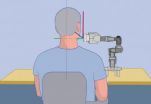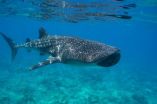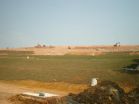(Press-News.org) Physicists at the Large Hadron Collider in Switzerland and even in the fictional world of CBS' "The Big Bang Theory" look to subatomic particles called neutrinos to answer the big questions about the universe.
Now, a group of scientists led by a physics professor with the College of Science at Virginia Tech are asking whether the neutrino could provide the world with clues about nuclear proliferation in Iran and other political hotspots.
Neutrinos are produced by the decay of radioactive elements, and nuclear reactors produce large amounts of neutrinos that cannot be shielded or disguised, which could help regulatory agencies monitor plutonium production.
Measuring neutrino emissions allows scientists to infer the plutonium content of a reactor from outside the building, according to a letter due to be released in Physical Review Letters written by Patrick Huber, an associate professor of physics and a member of the Center for Neutrino Physics at Virginia Tech, with Thomas Shea, a 20-year veteran of the International Atomic Energy Agency, and graduate students Eric Christensen of Westminster, Maryland, a doctoral student in physics, and Patrick Jaffke of Arlington, Virginia, a doctoral student in physics and a master's student in nuclear engineering.
"By making moderate improvements in existing neutrino-detector technology, we can fit a detector system into a standard 20-foot shipping container to monitor the Iranian heavy water reactor at Arak as part of a non-proliferation measure," Huber said. "Neutrino monitoring is non-intrusive and doesn't rely on a continuous history of reactor operations."
Monitoring antineutrinos — subatomic particles akin to the neutrino, except they spin in a different direction — also could help distinguish varying levels of fuel enrichment.
The Iranian 40 megawatt heavy water reactor at Arak has a design which is ideal for plutonium production for nuclear weapons and the International Atomic Energy Agency needs to be able to verify whether operations at the facility are for peaceful purposes.
Antineutrino detectors can provide the agency with high-level monitoring not currently offered by any other technique, the researchers say. This monitoring is based on the spectrum of antineutrinos produced by fission of uranium-235, plutonium-239, uranium-238, and plutonium-241, where the plutonium isotopes produce neutrinos with a lower average energy.
The paper is the result of an interdisciplinary collaboration between Huber's group at Virginia Tech's College of Science and Shea, with funding from the U.S. Department of Energy and the Institute for Society, Culture, and Environment at Virginia Tech.
For being such tiny particles, neutrinos have made big headlines.
They travel at about the speed of light, unimpeded by electromagnetism and strong nuclear forces that affect other particles.
Studying them has provided insight into Albert Einstein's theory of the Standard Model of particle physics and has revealed astronomical information from the far reaches of the universe.
INFORMATION: END
Neutrino detectors could help curb nuclear weapons activity
2014-08-12
ELSE PRESS RELEASES FROM THIS DATE:
Focal blood-brain-barrier disruption with high-frequency pulsed electric fields
2014-08-12
A team of researchers from the Virginia Tech-Wake Forest University School of Biomedical Engineering and Sciences have developed a new way of using electricity to open the blood-brain-barrier (BBB). The Vascular Enabled Integrated Nanosecond pulse (VEIN pulse) procedure consists of inserting minimally invasive needle electrodes into the diseased tissue and applying multiple bursts of nanosecond pulses with alternating polarity. It is thought that the bursts disrupt tight junction proteins responsible for maintaining the integrity of the BBB without causing damage to the ...
A highly sensitive microsphere-based assay for early detection of Type I diabetes
2014-08-12
A team of researchers from the Center for Engineering in Medicine at the Massachusetts General Hospital have developed a novel fluorescence-based assay for sensitive detection of antibodies within microliter volume serum samples. This new assay is at least 50 times more sensitive than the traditional radioimmunoassay (RIA), which is the gold standard currently used in the clinic. This new technology is particularly attractive for immunological assays as it allows: 1) use of very small volumes of sample reagents (5 ¦ÌL), and 2) use of traditional analytical systems such ...
Biomarker could reveal why some develop post-traumatic stress disorder
2014-08-12
(NEW YORK – August 11) Blood expression levels of genes targeted by the stress hormones called glucocorticoids could be a physical measure, or biomarker, of risk for developing Post-Traumatic Stress Disorder (PTSD), according to a study conducted in rats by researchers at the Icahn School of Medicine at Mount Sinai and published August 11 in Proceedings of the National Academy of Sciences (PNAS). That also makes the steroid hormones' receptor, the glucocorticoid receptor, a potential target for new drugs.
Post-Traumatic Stress Disorder (PTSD) is triggered by a terrifying ...
Robotic-assisted imaging: from trans-Atlantic evaluation to help in daily practice
2014-08-12
While in Germany, Partho P. Sengupta, MD, of Icahn School of Medicine at Mount Sinai used a computer to perform a robot-assisted trans-Atlantic ultrasound examination on a person in Boston. In another study Kurt Boman, MD, of Umeå University in Sweden in collaboration with Mount Sinai, showed how a cardiologist's video e-consultation, coupled with a remote robot-assisted echocardiogram test, dramatically reduces the waiting time for a diagnosis faced by heart failure patients who live in a rural communities far from the hospital from nearly four months to less than one ...
The Maldives and the whale shark: The world's biggest fish adds value to paradise
2014-08-12
They are the largest fish in the world but the impact of this majestic and charismatic animal on the economy of the island nation of the Maldives was largely unknown. A new study by scientists of the Maldives Whale Shark Research Programme (MWSRP) reveals that a small group of whale sharks in a single Maldivian Atoll accounts for nearly 3% of the global shark ecotourism and nearly half that of the Maldives'.
"The Republic of Maldives hosts one of few known year round aggregation sites for whale sharks", said James Hancock co-author and a director of MWSRP. "We have seen ...
Is empathy in humans and apes actually different?
2014-08-12
Whether or not humans are the only empathic beings is still under debate. In a new study, researchers directly compared the 'yawn contagion' effect between humans and bonobos (our closest evolutionary cousins). By doing so they were able to directly compare the empathic abilities of ourselves with another species, and found that a close relationship between individuals is more important to their empathic response than the fact that individuals might be from the same species.
The ability to experience others' emotions is hard to quantify in any species, and, as a result, ...
Sniffing out billions in US currency smuggled across the border to Mexico
2014-08-12
SAN FRANCISCO, Aug. 12, 2014 — Criminals are smuggling an estimated $30 billion in U.S. currency into Mexico each year from the United States, but help could be on the way for border guards, researchers will report here today. The answer to the problem: a portable device that identifies specific vapors given off by U.S. paper money.
They will present the new research at the 248th National Meeting & Exposition of the American Chemical Society (ACS), the world's largest scientific society. The meeting features nearly 12,000 reports on new advances in science and other ...
Could hemp nanosheets topple graphene for making the ideal supercapacitor?
2014-08-12
SAN FRANCISCO, Aug. 12, 2014 — As hemp makes a comeback in the U.S. after a decades-long ban on its cultivation, scientists are reporting that fibers from the plant can pack as much energy and power as graphene, long-touted as the model material for supercapacitors. They're presenting their
research, which a Canadian start-up company is working on scaling up, at the 248th National Meeting & Exposition of the American Chemical Society (ACS), the world's largest scientific society.
The meeting features nearly 12,000 presentations on a wide range of science topics and ...
Stinky gases emanating from landfills could transform into clean energy
2014-08-12
SAN FRANCISCO — A new technique that transforms stinky, air-polluting landfill gas could produce the sweet smell of success as it leads to development of a fuel cell generating clean electricity for homes, offices and hospitals, researchers say. The advance would convert methane gas into hydrogen, an efficient, clean form of energy.
The researcher's report is part of the 248th National Meeting of the American Chemical Society (ACS), the world's largest scientific society.
The meeting, attended by thousands of scientists, features nearly 12,000 reports on new advances ...
Climate change, predators, and the trickle down effects on ecosystems
2014-08-12
Predators play important roles in maintaining diverse and stable ecosystems. Climate change can push species to move in order to stay in their climatic comfort zones, potentially altering where species live and how they interact, which could fundamentally transform current ecosystems.
A symposium focusing on climate's effects on predators—causing cascading effects on whole ecosystems -- will take place on Tuesday, August 12th during the Ecological Society of America's 99th Annual Meeting, held this year in Sacramento, California.
There will be "winners" and "losers" ...





